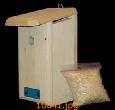
   |
 |
|
|
Warbler Houses
|
||||||||||||||||||||||||||||||||||||||||||||||||||||||||
 Coveside Titmouse/Warbler/Swallow Bird House
Coveside Titmouse/Warbler/Swallow Bird House
Titmice are generally comfortable around people. Prefer a natural habitat in areas with tall vegetation and a forest with a dense canopy of trees. House also suitable for Prothonotary Warblers, Tree Swallows, House Finches, Violet-green Swallows & Carolina Wrens. RANGE: Resides in southern Wisconsin, southern Michigan, central New York, southern New England south to Gulf of Mexico and central Florida. HABITAT: Thrives in deciduous, coniferous forests; swamps, orchards, suburban shade trees. (12-1/2"h x 6"w x 8-1/2"d) |
 Coveside Wood Chips Nesting Material
Coveside Wood Chips Nesting MaterialNesting Material. Gallon size. |
 Coveside Wood Predator Guard
Coveside Wood Predator Guard
Used to protect baby birds form predators reaching in and grabbing them. |
|
Ads by Google |

Home
Page |
Product Review Page | Help
 Woodside Gardens
The Registry of Nature Habitats
Woodside Gardens
The Registry of Nature Habitats 
 1999 -
1999 -
All Rights Reserved
Last Updated: